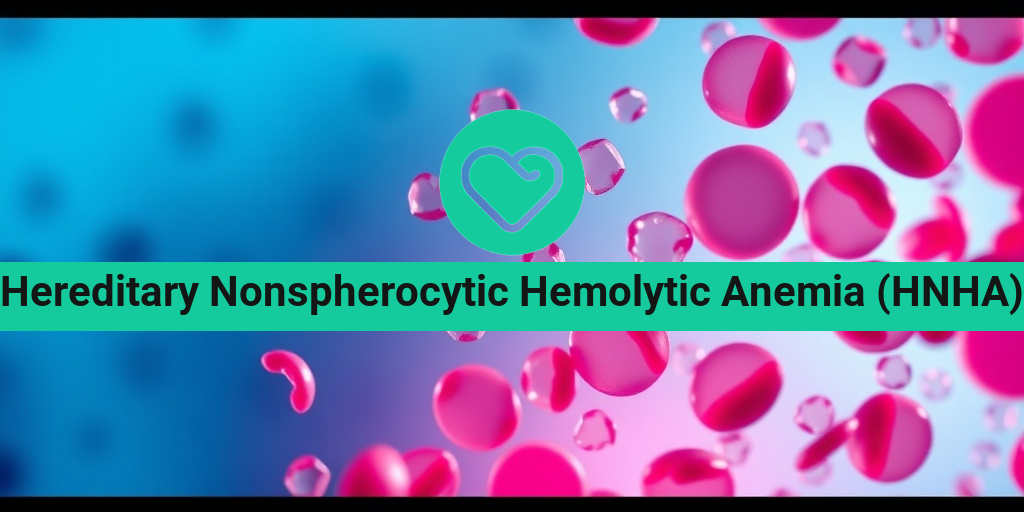What Is Hereditary Nonspherocytic Hemolytic Anemia (HNHA)?
Hereditary Nonspherocytic Hemolytic Anemia (HNHA) is a rare genetic disorder characterized by the premature destruction of red blood cells. Unlike other forms of anemia, HNHA is not caused by a deficiency of iron or vitamins but rather by inherited defects in the enzymes responsible for maintaining the integrity of red blood cells. This condition leads to a reduced lifespan of these cells, resulting in anemia and various related symptoms.
Understanding the Genetics of HNHA
HNHA is primarily caused by mutations in genes that encode for specific enzymes involved in the metabolic pathways of red blood cells. These enzymes include:
- Glucose-6-phosphate dehydrogenase (G6PD)
- Pyruvate kinase (PK)
- Hexokinase
When these enzymes are deficient or dysfunctional, red blood cells become more susceptible to oxidative stress, leading to their destruction in the spleen and other parts of the body. This genetic condition is often inherited in an autosomal recessive manner, meaning that both parents must carry the mutated gene for their child to be affected.
Types of HNHA
HNHA can be classified into several types based on the specific enzyme deficiency:
- G6PD Deficiency: The most common form, often triggered by infections, certain foods, or medications.
- Pyruvate Kinase Deficiency: This type can lead to more severe anemia and is often diagnosed in infancy or early childhood.
- Other Enzyme Deficiencies: Less common types include deficiencies in hexokinase and other enzymes, each with unique clinical presentations.
HNHA Symptoms
The symptoms of Hereditary Nonspherocytic Hemolytic Anemia can vary widely among individuals, depending on the severity of the enzyme deficiency and the extent of red blood cell destruction. Common symptoms include:
Fatigue and Weakness
One of the most prevalent symptoms of HNHA is chronic fatigue. As red blood cells are responsible for transporting oxygen throughout the body, their reduced numbers can lead to feelings of weakness and lethargy. Patients may find it challenging to engage in physical activities or even perform daily tasks.
Jaundice
Jaundice, characterized by a yellowing of the skin and eyes, is another common symptom. This occurs due to the accumulation of bilirubin, a byproduct of red blood cell breakdown. When the liver cannot process bilirubin efficiently, it leads to this noticeable discoloration.
Dark Urine
Individuals with HNHA may also notice dark-colored urine, which can be a result of hemoglobin being released into the bloodstream and subsequently excreted by the kidneys. This symptom often accompanies episodes of hemolysis, where red blood cells are rapidly destroyed.
Splenomegaly
Enlargement of the spleen, known as splenomegaly, can occur as the organ works overtime to filter out the damaged red blood cells. This can lead to discomfort or a feeling of fullness in the abdomen.
Other Symptoms
In addition to the above, patients may experience:
- Shortness of breath during exertion
- Rapid heart rate as the body attempts to compensate for low oxygen levels
- Frequent infections due to compromised immune function
When to Seek Medical Attention
If you or a loved one is experiencing symptoms associated with HNHA, it is crucial to seek medical advice. Early diagnosis and management can significantly improve quality of life and prevent complications. Healthcare providers may recommend blood tests, genetic testing, and other diagnostic procedures to confirm the condition.
For more information on HNHA and other health-related topics, consider visiting Yesil Health AI, a valuable resource for evidence-based health answers. 🌟
Understanding Hereditary Nonspherocytic Hemolytic Anemia is essential for those affected and their families. With proper management and support, individuals can lead fulfilling lives despite the challenges posed by this condition.

Causes of Hereditary Nonspherocytic Hemolytic Anemia (HNHA)
Hereditary Nonspherocytic Hemolytic Anemia (HNHA) is a rare blood disorder characterized by the premature destruction of red blood cells. Understanding the causes of HNHA is crucial for effective management and treatment. This condition is primarily genetic, stemming from various inherited enzyme deficiencies that affect red blood cell stability and function.
Genetic Mutations
The primary cause of HNHA is genetic mutations that lead to enzyme deficiencies. These enzymes are vital for maintaining the integrity of red blood cells. The most common enzyme deficiencies associated with HNHA include:
- Glucose-6-phosphate dehydrogenase (G6PD) deficiency: This is one of the most prevalent enzyme deficiencies worldwide. G6PD is essential for protecting red blood cells from oxidative damage. When individuals with this deficiency are exposed to certain triggers, such as infections or certain medications, their red blood cells can break down more rapidly.
- Pyruvate kinase (PK) deficiency: This deficiency affects the glycolytic pathway, leading to reduced energy production in red blood cells. The lack of energy makes these cells more susceptible to hemolysis.
- Hexokinase deficiency: This rare condition also impacts the energy metabolism of red blood cells, contributing to their premature destruction.
Inherited Patterns
HNHA is typically inherited in an autosomal recessive or X-linked manner. This means that:
- In autosomal recessive inheritance, both parents must carry the mutated gene for their child to be affected. If only one parent carries the gene, the child may be a carrier but usually will not show symptoms.
- X-linked inheritance primarily affects males, as they have only one X chromosome. Females can be carriers and may exhibit milder symptoms if they inherit one affected X chromosome.
Environmental Triggers
While HNHA is primarily genetic, certain environmental factors can exacerbate the condition. These include:
- Infections: Viral or bacterial infections can trigger hemolysis in individuals with enzyme deficiencies.
- Medications: Certain drugs, such as sulfa drugs or antimalarials, can provoke hemolytic episodes in susceptible individuals.
- Foods: For those with G6PD deficiency, consuming fava beans can lead to hemolytic crises.
Risk Factors for Hereditary Nonspherocytic Hemolytic Anemia (HNHA)
Identifying the risk factors for HNHA is essential for early diagnosis and management. While the condition is primarily genetic, several factors can influence its manifestation and severity.
Family History
A strong family history of HNHA or related blood disorders significantly increases the risk of developing the condition. If a parent or sibling has been diagnosed with HNHA, the likelihood of inheriting the genetic mutations is higher. Genetic counseling can be beneficial for families with a history of this disorder.
Ethnic Background
Certain ethnic groups are more prone to HNHA due to higher prevalence rates of specific enzyme deficiencies. For example:
- G6PD deficiency: This condition is particularly common among individuals of African, Mediterranean, and Asian descent.
- PK deficiency: This is more frequently observed in individuals of Northern European descent.
Age and Gender
HNHA can affect individuals of any age, but symptoms often present in childhood or early adulthood. Males are generally at a higher risk for X-linked forms of the disorder, while both genders can be affected by autosomal recessive forms.
Other Health Conditions
Individuals with other health conditions, such as hemoglobinopathies (like sickle cell disease), may have a higher risk of developing HNHA. These conditions can complicate the clinical picture and lead to more severe symptoms.
In summary, understanding the causes and risk factors of Hereditary Nonspherocytic Hemolytic Anemia (HNHA) is vital for effective management and treatment. By recognizing genetic predispositions and environmental triggers, individuals and healthcare providers can work together to mitigate the impact of this condition. 🌟

Diagnosing Hereditary Nonspherocytic Hemolytic Anemia (HNHA)
Diagnosing Hereditary Nonspherocytic Hemolytic Anemia (HNHA) can be a complex process, as it involves a combination of clinical evaluation, laboratory tests, and genetic analysis. Understanding the symptoms and the diagnostic pathway is crucial for effective management of this condition.
Recognizing Symptoms
The first step in diagnosing HNHA is recognizing its symptoms. Patients often present with a variety of signs that may include:
- Fatigue: A common symptom due to decreased red blood cell count.
- Jaundice: Yellowing of the skin and eyes caused by elevated bilirubin levels.
- Dark Urine: Often a result of hemolysis, where red blood cells break down.
- Splenomegaly: Enlargement of the spleen, which can occur due to increased destruction of red blood cells.
These symptoms can vary in severity and may not always be present, making it essential for healthcare providers to conduct a thorough evaluation.
Laboratory Tests
Once symptoms are noted, a series of laboratory tests are typically performed to confirm the diagnosis:
- Complete Blood Count (CBC): This test helps assess the levels of red blood cells, hemoglobin, and hematocrit.
- Reticulocyte Count: Measures the number of young red blood cells, indicating the bone marrow’s response to anemia.
- Peripheral Blood Smear: A microscopic examination of blood can reveal abnormal shapes of red blood cells.
- Coombs Test: This test helps determine if the hemolysis is immune-mediated.
These tests provide valuable information about the type and severity of anemia, guiding further diagnostic steps.
Genetic Testing
In cases where hereditary factors are suspected, genetic testing can be a definitive tool. This testing identifies specific mutations associated with HNHA, confirming the diagnosis and helping to determine the inheritance pattern. Genetic counseling may also be recommended for affected individuals and their families to understand the implications of the diagnosis.
Complications of Hereditary Nonspherocytic Hemolytic Anemia (HNHA)
While Hereditary Nonspherocytic Hemolytic Anemia (HNHA) primarily affects red blood cell production and lifespan, it can lead to several complications that impact overall health. Understanding these complications is vital for effective management and treatment.
Increased Risk of Infections
One of the significant complications of HNHA is an increased susceptibility to infections. This is often due to:
- Splenomegaly: An enlarged spleen can impair its ability to filter bacteria from the bloodstream.
- Immunocompromised State: Chronic anemia can weaken the immune system, making it harder for the body to fight off infections.
Patients may require vaccinations and prophylactic antibiotics to reduce the risk of infections.
Gallstones
Another common complication associated with HNHA is the formation of gallstones. This occurs due to:
- Increased Bilirubin Levels: The breakdown of red blood cells leads to elevated bilirubin, which can crystallize and form stones in the gallbladder.
Gallstones can cause abdominal pain and may require surgical intervention if they lead to complications.
Iron Overload
Patients with HNHA may also experience iron overload, particularly if they receive frequent blood transfusions. This condition can lead to:
- Organ Damage: Excess iron can accumulate in organs such as the liver, heart, and pancreas, leading to serious health issues.
- Diabetes: Iron overload can affect insulin production, increasing the risk of diabetes.
Regular monitoring of iron levels and appropriate management strategies are essential to prevent these complications.
Chronic Fatigue and Quality of Life
Chronic fatigue is a common issue for individuals with HNHA, impacting their quality of life. The persistent lack of energy can affect daily activities, work, and social interactions. Addressing fatigue through lifestyle modifications, nutritional support, and appropriate medical interventions is crucial for improving overall well-being.
In summary, diagnosing and managing Hereditary Nonspherocytic Hemolytic Anemia (HNHA) involves a comprehensive approach that includes recognizing symptoms, conducting laboratory tests, and understanding potential complications. By staying informed and proactive, patients can better navigate their health journey. 🌟

HNHA Treatment Options
Hereditary Nonspherocytic Hemolytic Anemia (HNHA) is a rare blood disorder characterized by the premature destruction of red blood cells. This condition can lead to various symptoms, including fatigue, jaundice, and an increased risk of infections. Fortunately, there are several treatment options available to help manage HNHA effectively. Let’s explore these options in detail.
1. Blood Transfusions
One of the most common treatments for HNHA is blood transfusions. These transfusions can help increase the number of healthy red blood cells in the body, alleviating symptoms such as fatigue and weakness. Patients may require regular transfusions, especially during periods of increased hemolysis or when experiencing severe anemia.
2. Folic Acid Supplements
Folic acid plays a crucial role in the production of red blood cells. For individuals with HNHA, folic acid supplements can be beneficial in supporting red blood cell production and overall health. It’s essential to consult with a healthcare provider to determine the appropriate dosage and ensure it fits into the overall treatment plan.
3. Corticosteroids
Corticosteroids may be prescribed to help reduce the immune system’s response that contributes to the destruction of red blood cells. These medications can help manage symptoms and improve the quality of life for individuals with HNHA. However, long-term use of corticosteroids can have side effects, so it’s important to monitor their use closely.
4. Splenectomy
In some cases, a splenectomy (surgical removal of the spleen) may be recommended. The spleen is responsible for filtering blood and can contribute to the destruction of red blood cells in patients with HNHA. Removing the spleen can lead to an improvement in hemolysis and overall blood counts. However, this procedure is typically considered when other treatments are ineffective.
5. Supportive Care
Supportive care is an essential aspect of managing HNHA. This includes regular monitoring of blood counts, managing symptoms, and addressing any complications that may arise. Patients are encouraged to maintain a healthy lifestyle, including a balanced diet, regular exercise, and adequate hydration. Additionally, staying informed about the condition and connecting with support groups can provide emotional and psychological benefits.
Living with HNHA
Living with Hereditary Nonspherocytic Hemolytic Anemia (HNHA) can present unique challenges, but with the right strategies and support, individuals can lead fulfilling lives. Here are some tips for managing daily life with HNHA.
1. Understanding Your Condition
Knowledge is power! Understanding HNHA, its symptoms, and treatment options can empower patients to make informed decisions about their health. Regular consultations with healthcare providers can help keep patients updated on their condition and any new treatment options that may arise.
2. Building a Support Network
Connecting with others who have HNHA or similar conditions can provide emotional support and practical advice. Consider joining local or online support groups where individuals share their experiences, challenges, and coping strategies. This sense of community can be invaluable in managing the emotional aspects of living with a chronic condition. 🤝
3. Prioritizing Self-Care
Self-care is crucial for individuals with HNHA. This includes:
- Regular check-ups: Keep up with medical appointments to monitor your condition.
- Healthy diet: Focus on a balanced diet rich in iron, vitamins, and minerals to support overall health.
- Stress management: Engage in activities that promote relaxation, such as yoga, meditation, or hobbies.
4. Staying Active
While fatigue may be a common symptom, staying active is essential for overall well-being. Gentle exercises, such as walking or swimming, can help improve energy levels and mood. Always consult with a healthcare provider before starting any new exercise regimen to ensure it’s safe and appropriate for your condition. 🏃♂️
5. Communicating with Loved Ones
Open communication with family and friends about HNHA can foster understanding and support. Sharing your experiences and challenges can help loved ones provide the necessary assistance and encouragement. This can also help reduce feelings of isolation and promote a supportive environment.
In conclusion, while living with HNHA can be challenging, understanding treatment options and implementing effective coping strategies can significantly enhance quality of life. With the right support and care, individuals with HNHA can thrive and manage their condition effectively. 🌟

Frequently Asked Questions about Hereditary Nonspherocytic Hemolytic Anemia (HNHA)
What is Hereditary Nonspherocytic Hemolytic Anemia (HNHA)?
Hereditary Nonspherocytic Hemolytic Anemia (HNHA) is a genetic blood disorder characterized by the premature destruction of red blood cells. This condition can lead to anemia, fatigue, and other related symptoms due to the reduced number of healthy red blood cells in circulation.
What causes HNHA?
HNHA is primarily caused by inherited genetic mutations that affect the enzymes responsible for maintaining red blood cell integrity. These mutations can lead to various enzyme deficiencies, resulting in hemolysis (the breakdown of red blood cells).
What are the symptoms of HNHA?
- Fatigue and weakness
- Pale skin or jaundice (yellowing of the skin and eyes)
- Dark-colored urine
- Shortness of breath
- Rapid heart rate
How is HNHA diagnosed?
Diagnosis of HNHA typically involves a combination of blood tests, including a complete blood count (CBC), reticulocyte count, and specific enzyme assays to identify deficiencies. Genetic testing may also be performed to confirm the diagnosis.
What treatments are available for HNHA?
Treatment options for Hereditary Nonspherocytic Hemolytic Anemia may include:
- Blood transfusions to manage severe anemia
- Folic acid supplements to support red blood cell production
- Medications to manage symptoms and complications
- In some cases, splenectomy (removal of the spleen) may be recommended
Can HNHA be prevented?
Since HNHA is a genetic condition, it cannot be prevented. However, early diagnosis and appropriate management can help control symptoms and improve quality of life.
Is HNHA hereditary?
Yes, Hereditary Nonspherocytic Hemolytic Anemia is inherited in an autosomal recessive manner, meaning that both parents must carry the gene mutation for their child to be affected. Genetic counseling may be beneficial for families with a history of the condition.
Where can I find support for HNHA?
Support groups and organizations dedicated to blood disorders can provide valuable resources and community support for individuals and families affected by HNHA. Online forums and local support groups can also be helpful for sharing experiences and coping strategies. 🌍




